The Bistoon Inscription, recognized as the world’s largest inscription on stone, is a precious remnants of the words of Darius the Great of the Achaemenid Empire. A treasure for all Iranians, it is located in the Bistoon site in Kermanshah. This inscription, placed at an unreachable height and unreadable from below, signifies that Darius the Great wrote his history not just for his contemporaries but for future generations as well.
Historical inscriptions and stone writings reveal the documented history of the Achaemenid and ancient Iran era, and it is a matter of great pride for Iranians to read the writings of Darius the Great in their original form without any intermediaries. In this article of Parsi Tours blog, we will go through the details of this amazing monument.
Where is the Bistoon Inscription Located?
The modern-day route starting from Hamadan, passing through cities like Kangavar, Kermanshah, Sarpol-e Zahab, Qasr-e Shirin, and Khosravi, reaching the land of Mesopotamia (between the rivers), is the same ancient road that connected the eastern and central territories of Iran to the western lands, Babylon, Nineveh, and other cities of Mesopotamia.
Along this route, especially in Bistoon, numerous ancient monuments are visible, reflecting the special attention of our ancestors.
The Bistoon Inscription, Iran’s seventh registered world heritage site by UNESCO, is among the must-see places in Kermanshah and is located 30 kilometers east of the city of Kermanshah. (See on the map)
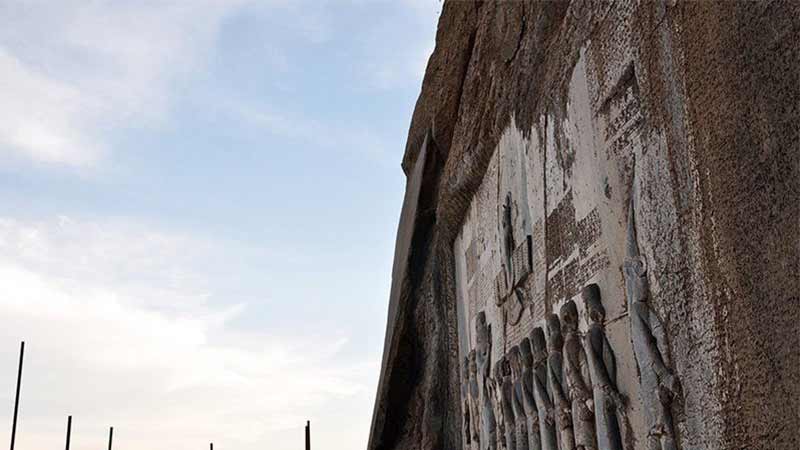
The Story Behind the Name ‘Bistoon’
The term “Bistoon” (often mispronounced as “Bisotoon” today) was known in the Achaemenid era and possibly earlier as Bagastana/Baghastana, meaning ‘the place of God’. Over time, it evolved into various forms like “Behistun/Bistoon/Bustan.” The Greek historian Diodorus Siculus (1st century BC) referred to it as Bagistan. After the advent of Islam, and its adoption in English and other European languages, it became known as Behistun, the Pahlavi pronunciation.
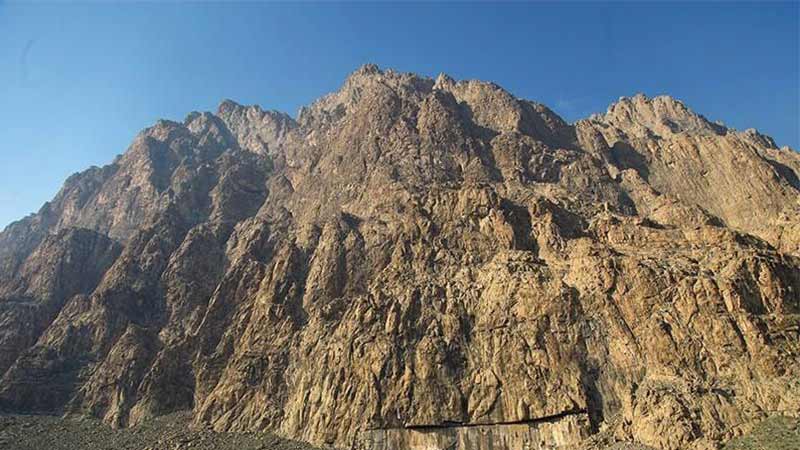
Deciphering the Bistoon Mystery
Among the earliest accounts of this inscription is that of Diodorus Siculus, who attributed the carving to the goddess Semiramis and a hundred spearmen surrounding it, claiming it was inscribed in Syriac under a relief.
Isidore of Charax, a geographer, referred to Bistoon as “Bapetana” in the area of Cambadene, mentioning a depiction of Semiramis there. Ibn Hawqal regarded it as a school mural, depicting a teacher with a strap in hand for disciplining students.
French traveler Gardanne, in 1794, interpreted the depiction as the twelve apostles of Christ and associated the image of Faravahar with Christ. Finally, between 1835 and 1844, the British Henry Rawlinson copied the text from this inscription.
His studies drew attention in 1857 from the Royal Asiatic Society in London, leading to the decipherment of the Bistoon Inscription.
Rawlinson’s work garnered the interest of many scholars, including Professor William Jackson from Columbia University, who visited in 1903 and further studied the inscription, primarily refining Rawlinson’s work.
The Bistoon Inscription features three types of script: Ancient Persian, Elamite, and Babylonian (Akkadian). The decipherment of Ancient Persian revealed that the images depicted Darius and his two generals, along with ten rebels who had revolted early in his reign, illustrating the suppression of these rebels.
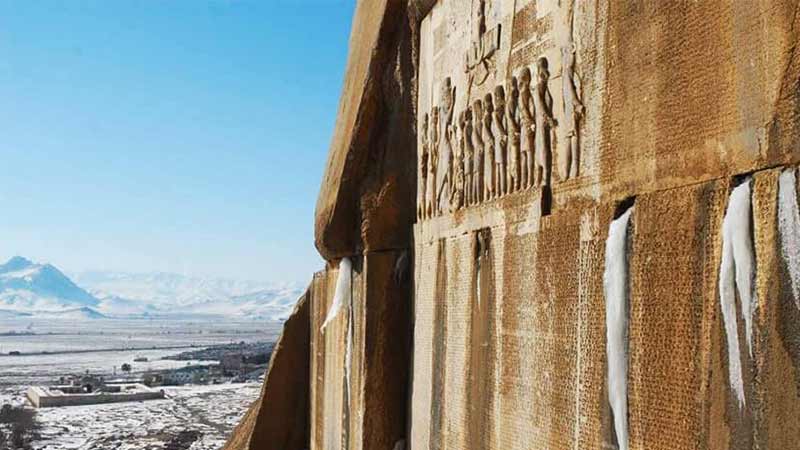
Suppressing the False Bardia Revolt
Based on the Bistoon Inscription, after the killing of the “False Bardia or Gaumata” by Darius the Great and six of his companions, the entire Persian Empire plunged into turmoil. However, Darius successfully quelled 16 revolts within a year and a few months (521-522 BC), restoring order and security across the empire.
He ordered a rock relief to immortalize the glory of these victories on the sacred mountain of Bistoon near Kermanshah.
The leader of the rebels, hands bound, stands in front of Darius, with “Gaumata” (the False Bardia) lying beneath his feet. Darius is depicted holding a bow in his left hand, with Faravahar hovering above. Surrounding this image is a report detailing the rebellions and Darius’s triumph over them, initially inscribed in Elamite but later translated into Babylonian (Akkadian) and Ancient Persian.
The addition of the Ancient Persian translation to this relief, following the invention of a special cuneiform script, was ordered by Darius. Interestingly, other copies of this inscription were sent to different provinces of the empire for public awareness.
This inscription is one of the most authentic and famous historical documents in the world, as it contains the most important cuneiform writing from the Achaemenid era. The total area covered by this inscription is 20.5 meters in length and 7.80 meters in width.
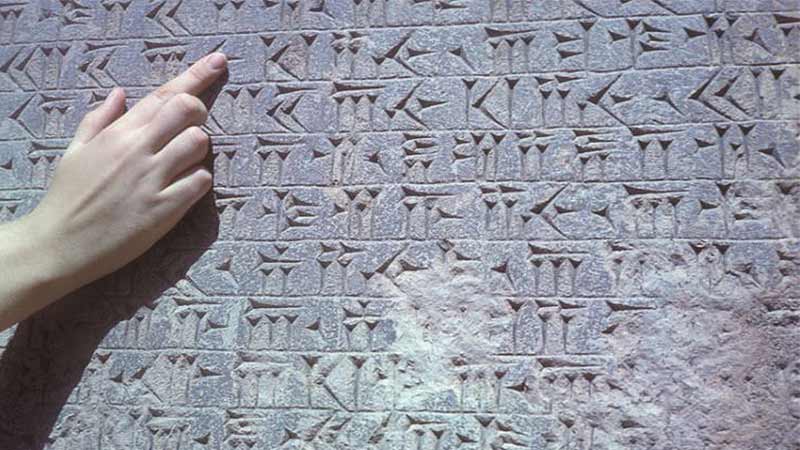
Description of the Relief Image
The relief of this historical artifact is carved over an area 6 meters long and 3.20 meters wide, featuring the image of Darius, an archer, a spear-bearer, and ten rebels. One rebel lies beneath Darius’s feet, and the remaining nine, hands bound, stand before him. Their heads, except for the first figure, are connected by a rope, and each wears distinct attire from their respective countries, differentiating them from each other. Above each is an inscription identifying the rebel and the location of their rebellion.
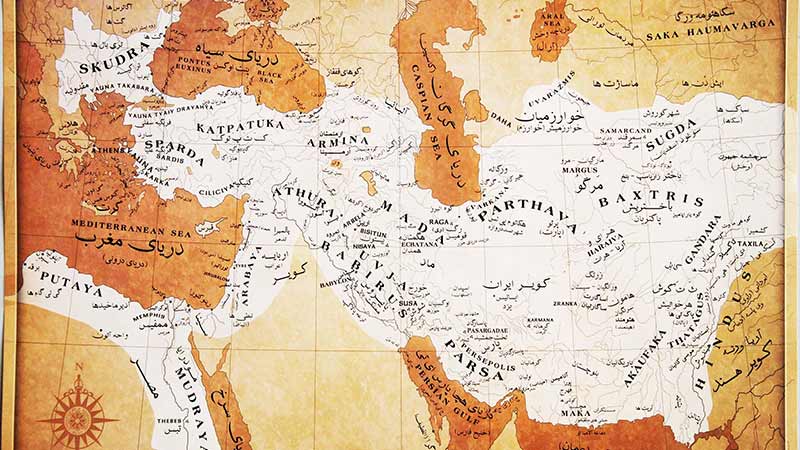
Darius and Ahura Mazda in Bistoon
The height of eight of these figures is 126 centimeters, while the last figure, Skunakha, with his hat, stands at 178 centimeters. The king is depicted in his true size, 181 centimeters, with his left foot and bow placed over the body of Gaumata, who lies prostrate beneath him. The king’s right hand is raised in worship towards Faravahar.
Symbolism in the Bistoon Inscription
Faravahar, a symbol of Ahura Mazda, faces the king, holding a ring in his left hand and raising his right hand, mirroring the king (seemingly a gesture of blessing). An eight-pointed star within a circle can be seen above the almost cylindrical hat of Faravahar, a motif also present on the beautifully winged crown worn by Darius, perhaps signifying his devotion to Ahura Mazda.
Behind Darius stand the archer and the royal spear-bearer. Both the king and his officers wear a long Persian garment and similar three-strapped shoes, but the headbands of the officers are decorated differently from Darius’s crown. The king’s rectangular beard, distinct from the short beards of the others, is an added piece, crafted from a separate stone and skillfully attached to Darius’s face.

Close-up View of Darius the Great at Bistoon
The precision and intricacy in the quiver, its strap, the pommels attached to the spear, the beard, and the headbands of the royal officers are all meticulously crafted. Gaumata is the only captive wearing laced shoes, while the others are barefoot.
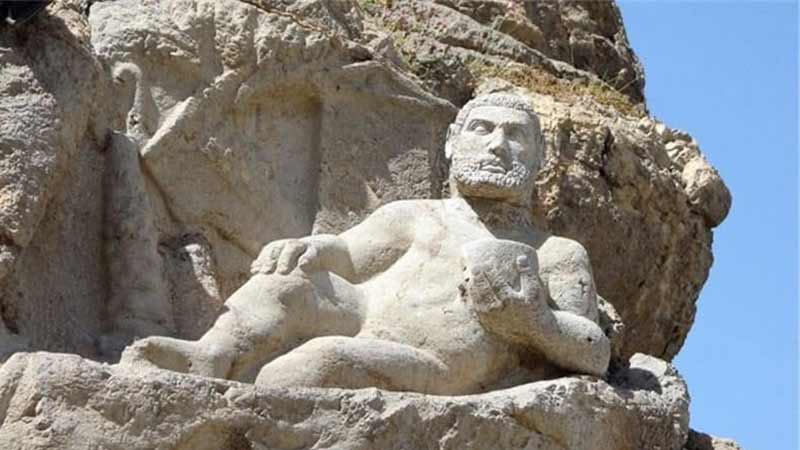
Bistoon Inscription in Kermanshah
There are 11 smaller inscriptions carved on the surface.
The Stone Writings
The arrangement of these lines in relation to the figures is as follows:
Under the figures, the Ancient Persian lines are in five columns, measuring 9.23 meters in length and 3.63 meters in width (or height), with 414 lines.
On the right side, next to the figures, an Elamite inscription measures 5.60 meters in length and 3.70 meters in width (or height), with the rest of this inscription on the left side, along the lines of Ancient Persian, measuring 5.67 meters in length and 3.63 meters in width, totaling 593 lines in eight columns.
The Akkadian (Babylonian) inscription is located at the top of the left side Elamite section, measuring 4 meters in height and ranging from 2.52 meters in width at the top to 2.31 meters at the bottom, forming a trapezoid with 112 lines.
The total lines and figures cover an area of 120 square meters.
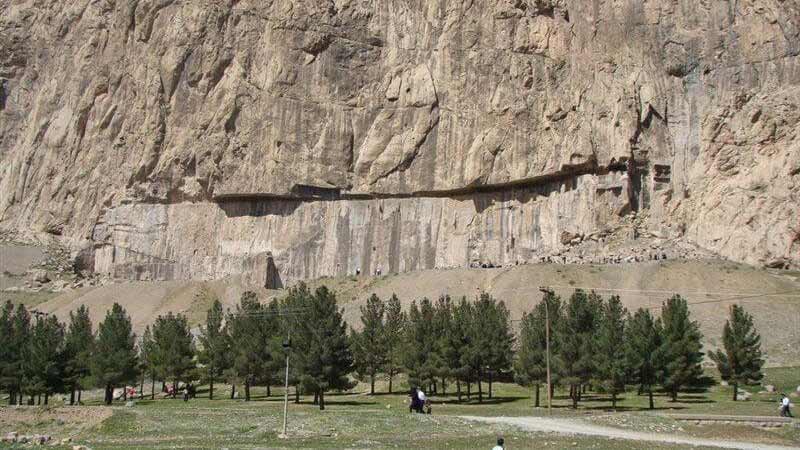
Construction Method of the Bistoon Inscription
For carving the Bistoon relief and inscription, a location several tens of meters above ground level and on the south-facing slope of Mount Paraw was chosen. However, it appears that at the time of its creation, there was an accessible path to the workshop site. Faint remnants of a staircase in the upper parts of the mountain and traces of carving the stone slabs beneath the inscription near the ground indicate the existence of a path leading upward. A path that the stone carvers, upon completion of their work and to render the inscription inaccessible, also carved and obliterated on their way down. Writing a historical inscription at such an unreachable height, unreadable from below the mountain, signifies that Darius composed this text not for his contemporaries but exclusively for future generations.
The carvings at Bistoon, in terms of technology and construction mechanics, are among the finest examples of Achaemenid art.
Carved Stones in Mount Bistoon
The exact tools and techniques used to carve such images on limestone, which remain polished and shiny even after 2,500 years, are unknown. The coffee-like glazed color seen across the inscription’s surface, possibly resulting from the oxidation of elements mixed in the limestone, suggests post-engraving treatments. Notably, traces of lead found within the letters of the first few lines of the Ancient Persian text imply that the inscriptions were filled with lead for durability, and the entire inscription was coated with an unknown substance for preservation.
During construction, any damaged stone surface was replaced with a precisely carved piece of the same size.
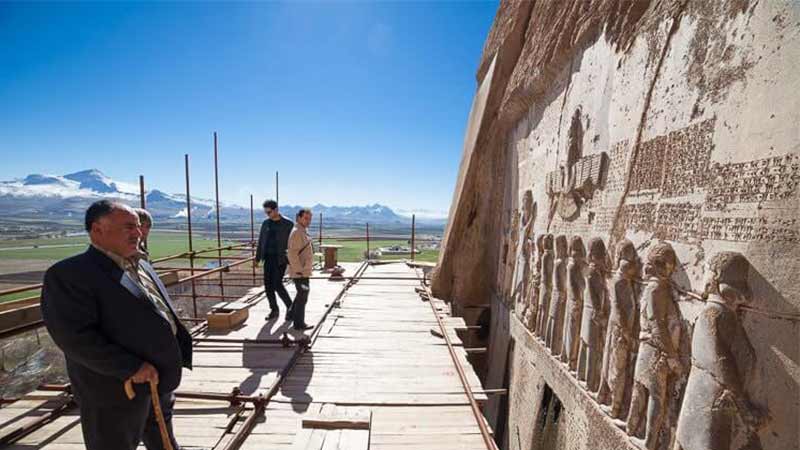
The Farvahar Symbol in the Bistoon Inscription
Examples of these repairs can be seen in the bow of Darius and his accompanying commander, as well as in the hat and hand of the “Winged Globe” (the national emblem of ancient Iran and symbol of the sun and Ahura Mazda).
Text of the Bistoon Inscription by Darius the Great, King of Kings of the Achaemenid Dynasty
This inscription is a significant historical record, tracing the lineage of the Achaemenid kings before Darius the Great. Darius begins his inscription with an introduction of himself:
Column 1: Cuneiform Writings of the Bistoon Inscription
- “I am Darius, the great king, king of kings, king of Persia, king of the nations, son of Hystaspes, grandson of Arsames, of the Achaemenid family.”
- Darius the king says: “My father is Hystaspes; the father of Hystaspes was Arsames; the father of Arsames was Ariaramnes; the father of Ariaramnes was Teispes; the father of Teispes was Achaemenes.”
- Darius the king says: “Therefore, we are called Achaemenids; we have been noble since ancient times; our ancestors were kings from long ago.”
- Darius the king says: “Eight of my ancestors were kings; I am the ninth. Nine generations of us have been kings.”
- Darius the king says: “By the grace of Ahura Mazda, I am the king. Ahura Mazda gave the kingship to me.”
- Darius the king says: “These are the countries which came under my possession; by the will of Ahura Mazda, I became king of them: Persia, Elam, Babylon, Assyria, Arabia, Egypt, the sea people (Phoenicians), Lydia, the Greeks in Asia Minor, Media, Armenia, Cappadocia, Parthia, Drangiana, Aria, Bactria, Sogdia, Gandhara, Scythians, Sattagydia, Arachosia, Maka, and others, totaling 32 lands.”
- Darius the king says: “These are the countries which became mine; they brought tribute to me; what was said to them by me, by night or by day, was done by them.”
- Darius the king says: “In these lands, a man who was loyal, I rewarded him well; who was rebellious, I severely punished. By the will of Ahura Mazda, these lands respected my laws; as it was commanded by me, so it was done.”
- Darius the king says: “Ahura Mazda granted me this empire. Ahura Mazda helped me to obtain this empire. With the help of Ahura Mazda, I hold this empire.”
- Darius the king says: “This is what was done by me after I became king. Cambyses, the son of Cyrus of our family, he was king here before me. Cambyses had a brother, Bardiya, who had the same mother and father as Cambyses. After Cambyses, Bardiya was killed; it was not known by the people that Bardiya was killed. After that, Cambyses went to Egypt, and the people became disobedient. Then lies spread greatly throughout the land, in Persia, in Media, and in other provinces.”
- Darius the king says: “After that, a Magian named Gaumata arose; he was from a mountain called Arakadri. He lied to the people saying, ‘I am Bardiya, the son of Cyrus, the brother of Cambyses.’ Then all the people turned away from Cambyses and went over to him, both in Persia and Media, and the other provinces. He seized the kingdom; on the fourteenth day of the month Viyakhna, he became king. After that, Cambyses died by his own hand.”
- Darius the king says: “There was no man, neither Persian nor Median nor any one of our family, who could take the kingdom from Gaumata, the Magian. The people feared him greatly because he killed many people who had known Bardiya before. He killed them so they might not recognize that he was not Bardiya, the son of Cyrus. No one dared say anything about Gaumata, the Magian, until I arrived. Then I prayed to Ahura Mazda for help. Ahura Mazda granted me help. On the tenth day of the month Bagayadish, I, along with several men, killed that Gaumata, the Magian, and those who were his chief followers. I killed him in a fort called Sikayauvati in the district of Nisaya in Media. I took the kingdom from him. By the grace of Ahura Mazda, I became king. Ahura Mazda granted me the kingdom.”
- Darius the king says: “The kingdom that had been taken away from our family, I restored it. I established it firmly in its place. As it had been before, so I did. The sanctuaries which Gaumata, the Magian, had destroyed, I restored. The pastures, herds, slaves, and houses which Gaumata, the Magian, had taken away, I returned to the people. I established the people in their place, both in Persia and Media and the other provinces. As it had been before, so I restored what had been taken away. By the grace of Ahura Mazda, I did this. I strove to restore our family to its place, as it had been before, so I strove by the will of Ahura Mazda, so that Gaumata, the Magian, did not take our family.”
- Darius the king says: “This is what I did after I became king.”
- Darius the king says: “After I killed Gaumata, the Magian, a man named Atrina, the son of Upadarma, rose in Susiana (Khuzestan). He lied to the people, saying, ‘I am the king of Susiana.’ After that, the Susianians became rebellious. They went over to that Atrina. He became king in Susiana. And a Babylonian man named Nidintu-Bel, the son of Aniri, rose in Babylon. He deceived the people, saying, ‘I am Nebuchadnezzar, the son of Nabonidus.’ After that, all the Babylonian people went over to that Nidintu-Bel. Babylon became rebellious. He seized the kingdom in Babylon.”
- Darius the king says: “After that, I went toward Babylon, against that Nidintu-Bel who called himself Nebuchadnezzar. The army of Nidintu-Bel held the Tigris. There he stood, and the water was deep. After that, I placed my army on rafts; some I mounted on camels; for others, I provided horses. Ahura Mazda granted me help. By the will of Ahura Mazda, we crossed the Tigris. There I smote the army of Nidintu-Bel very much. On the twenty-sixth day of the month Athriyadiya, we crossed over.”
- Darius the king says: “After that, I went toward Babylon. I had not yet reached Babylon when in a town called Zazana by the Euphrates, this Nidintu-Bel who called himself Nebuchadnezzar came with an army to offer battle against me. After that, we fought. Ahura Mazda granted me help. By the will of Ahura Mazda, I smote the army of Nidintu-Bel very much. The remainder were thrown into the water. The water carried them away. On the second day of the month Anamaka, we fought in this way.”
Column 2:
- Darius the king says: “After that, Nidintu-Bel with a few horsemen fled; he went toward Babylon. After that, I went toward Babylon. By the will of Ahura Mazda, I captured both Babylon and Nidintu-Bel. After that, I killed Nidintu-Bel in Babylon.”
- Darius the king says: “As long as I was in Babylon, these are the countries that became rebellious against me: Persia, Susiana, Media, Assyria, Egypt, Parthia, Margiana, Sattagydia, Scythia.”
- Darius the king says: “A man named Martiya, the son of Chishpish, from the city of Gogana in Persia, he arose in Susiana. He lied to the people, saying, ‘I am Imanish, the king in Susiana.'”
- Darius the King says: “At that time, I was near Khuzestan. Subsequently, the people of Khuzestan, stricken with fear of me, captured and killed Martiya, their leader.”
- Darius the King says: “A Median man named Fravartish rose in Media. He claimed to be Khshathrita of the lineage of Uvakhshatra. Afterward, the Median army, stationed in his palace, rebelled against me and joined Fravartish, who then became king in Media.”
- Darius the King says: “The Persian and Median forces under my command were limited. Following this, I dispatched my army, appointing a Persian named Vidarna as their leader. I instructed them to attack the rebellious Median troops who refused to acknowledge me. Then Vidarna advanced with the army, and upon reaching Media, engaged in battle at a town called Marush in Media. The Median leader was not present there. With Ahura Mazda’s help, my forces significantly defeated the disloyal troops. This occurred 27 days after the month Anamaka.”
- Darius the King says: “I sent my Armenian servant Dadarshi to Armenia with these orders: ‘Confront and defeat the rebellious troops who refuse my rule.’ Subsequently, Dadarshi set out. When he reached Armenia, the rebels assembled and confronted Dadarshi in battle at a place called Zuzahya in Armenia. With Ahura Mazda’s aid, my forces overwhelmingly defeated the rebels, about 7-8 days into the month Thauravahara.”
- Darius the King says: “Again, the rebels assembled and fought against Dadarshi in Armenia, at a fortress named Tigran. With the help of Ahura Mazda, my army decisively defeated the rebels. This battle occurred 18 days into the month Thauravahara.”
- Darius the King says: “For a third time, the rebels gathered and battled against Dadarshi in Armenia, at a fortress called Uyama. With Ahura Mazda’s assistance, my army crushed the rebels. This occurred 8-9 days into the month Thaigarshi. Following this, Dadarshi remained in Armenia on my behalf until I arrived in Media.”
- Darius the King says: “I then sent my Persian servant Vahumisa to Armenia with these orders: ‘Advance and defeat the rebellious troops that do not acknowledge my rule.’ Upon his arrival in Armenia, Vahumisa faced rebels who had assembled for battle in a land called Izala in Assyria. With Ahura Mazda’s support, my forces severely defeated them. This happened 15 days after the month Anamaka.”
- Darius the King says: “Once again, the rebels assembled and fought against Vahumisa in Armenia, in a land called Atiyar. With Ahura Mazda’s aid, my army significantly defeated the rebels near the end of the month Thauravahara. Afterwards, Vahumisa waited for me in Armenia until I reached Media.”
- Darius the King says: “Subsequently, I departed Babylon and headed towards Media. Upon arrival, I encountered Fravartish, who claimed kingship in Media, in a battle at the town of Kundurush. With Ahura Mazda’s support, my army decisively defeated Fravartish’s forces. This occurred 10-25 days into the month Adhukanaiish.”
- Darius the King says: “Afterwards, Fravartish fled with a few horsemen towards the land of Ray in Media. I sent a force after him, and they captured and brought him to me. I ordered mutilation of his nose, ears, tongue, and one eye, and displayed him at my palace gate for all to see. Then, I executed him in Hamadan, along with his prominent supporters, who were hanged in a fortress there.”
- Darius the King says: “A man named Citrantakhma in Sagartia rebelled against me, claiming to be a king of Sagartian descent. I dispatched Persian and Median forces under a Median named Taxmaspada. I ordered them to defeat the rebellious troops. Taxmaspada then engaged and defeated Citrantakhma, bringing him to me. I ordered mutilation of his nose, ears, and one eye, and displayed him at my palace gate. He was then executed in Arbela.”
- Darius the King says: “This recounts what I accomplished in Media.”
- Darius the King says: “Parthia and Hyrcania rebelled against me, aligning themselves with Fravartish. My father, Hystaspes, was in Parthia at the time, where the people had turned rebellious. Hystaspes advanced with his loyal forces and battled the Parthians at a place called Vispazati in Parthia. With the aid of Ahura Mazda, Hystaspes decisively defeated the rebel forces. This occurred 24 days into the month Viyakhna.”



